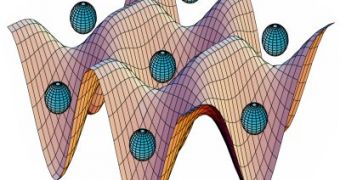According to German and Hungarian physicists, the use of ultracold atoms in an optical lattice can simulate a number of aspects in QCD (chromodynamics), so by cooling atoms like lithium-6 into a Fermi condensate, they could be made to behave like quarks.
An optical lattice is formed by using counterpropagating laser beams to create a periodic (in space) intensity pattern. The resulting periodic potential can then be used to trap neutral atoms via the Stark shift. This system of trapped atoms resembles a crystal in the sense that the atoms are localized periodically in space.
By doing this, many unsolved problems in QCD could be explained, without employing the extremely difficult computer simulations.
Quantum chromodynamics is the theory of the strong interaction (color force), a fundamental force describing the interactions of the quarks and gluons found in hadrons (such as the proton, neutron or pion). QCD is a quantum field theory of a special kind called a non-abelian gauge theory. It is an important part of the Standard Model of particle physics.
In condensed matter physics, the Fermi surface is an abstract boundary useful for predicting the thermal, electrical, magnetic and optical properties of metals, semimetals and doped semiconductors. The shape of the Fermi surface is derived from the periodicity and symmetry of the crystalline lattice and from the occupation of electronic energy bands. The existence of a Fermi surface is a direct consequence of the Pauli exclusion principle, which prevents fermions from all crowding into the same state.
They are formed when particles with a half-integer spin number, known as fermions, pair up at very low temperatures and collectively fall into the same quantum state. They can be created by loading ultracold atoms into an "optical lattice", which is an array of energy wells formed by crisscrossing laser beams. The strength of the interactions between the particles in the pair can then be "tuned" by applying a magnetic field to the lattice, an ability that allows physicists to simulate the pairing of electrons in high-temperature superconductors and other poorly-understood states of matter.
Walter Hofstetter from J. W. Goethe University, however, has thought of an altogether different application, using an optical lattice as a physical simulation of how quarks interact via the theory of QCD. Quarks are always bound together within hadrons as pairs or triplets according to their "colour", which can be either red green or blue. Hofstetter's team thinks that if an optical lattice were prepared containing ultracold fermionic atoms with three closely-spaced, "hyperfine" states, the states would be analogous to the three colours of quarks and so the cold atom system could be used as a "toy model" of QCD.
"An experimental implementation of our model with cold atoms would be much more powerful than any numerical simulation on a classical computer, because quantum many-body systems quickly become very complicated," said Hofstetter. "It would be similar to the speedup of a quantum computer compared to a classical one for more specialized purposes."

 14 DAY TRIAL //
14 DAY TRIAL //